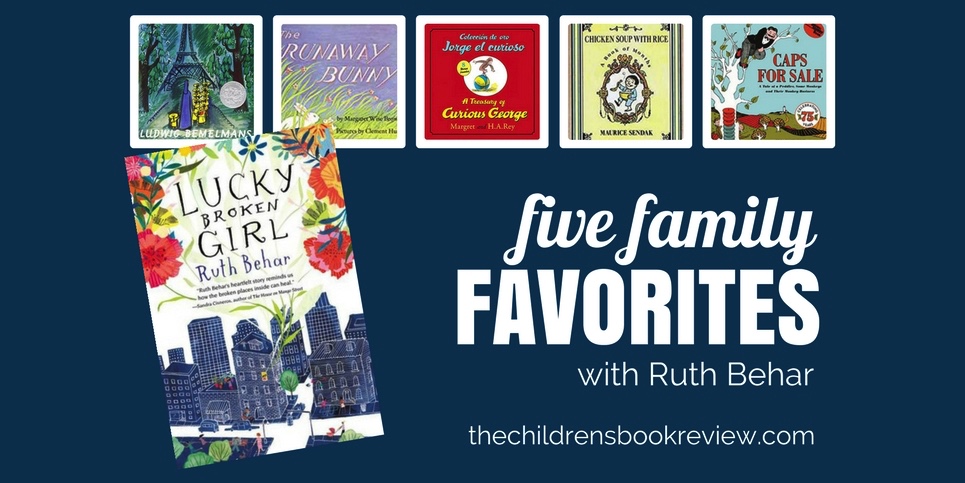Ruth Behar | The Children’s Book Review | April 30, 2017
I read many books to my son Gabriel when he was a little boy. Somehow the years have passed and Gabriel has now turned thirty and is soon to be married. Lately I buy children’s books anticipating I might share them with a grandchild one day. Also, having recently leapt into the field of young people’s literature, I am trying to catch up fast with the amazing books that are being written for kids, as well as with the classics I missed out on when I was growing up. I was born in Cuba and arrived with my family to Queens, New York in the early 1960s. They placed me in a first-grade class before I knew a word of English. My parents struggled to make ends meet. Since they didn’t know English either, they couldn’t read books aloud to my brother and me, though my mother sang lullabies to us in Spanish. In any case, books were a luxury. The only way I could acquire books, beyond those I got in school, was by borrowing them from the bookmobile, a great invention for those of us in marginal neighborhoods. All the books I read to Gabriel in the late 1980s and early 1990s were books I discovered with him, creating for my son an American childhood in Ann Arbor, Michigan that was nothing like my childhood as an immigrant kid in New York. Here are five classic books we read and reread, while my thoughts sometimes wandered.
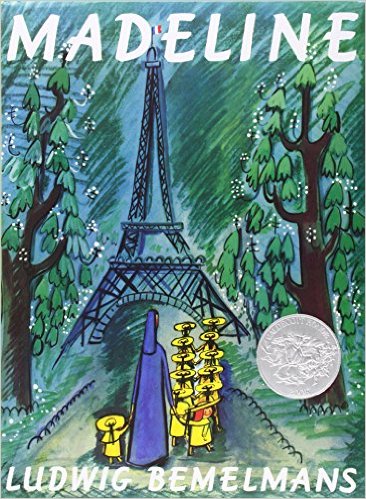 Madeline
Madeline
Written and Illustrated by Ludwig Bemelmans
Gabriel and I enjoyed reading Madeline together. I thought it a good idea to show my son that girls are every bit as brave as boys and he seemed to take in that message without much fanfare. After her appendix is removed, Madeline proudly shows off the scar on her stomach to the girls from her boarding school when they come visit her at the hospital. This feisty girl brought back memories of my friend, Dinah, who was from Belgium and spoke French, and seemed very sophisticated to me when we were girls growing up in working-class Queens.
(Simon and Schuster, 1939).
Order a Copy Now: Indiebound | Amazon | Barnes and Noble
Ages 3-7 | Publisher: The Viking Press | 1967 | ISBN-13: 978-0670445806
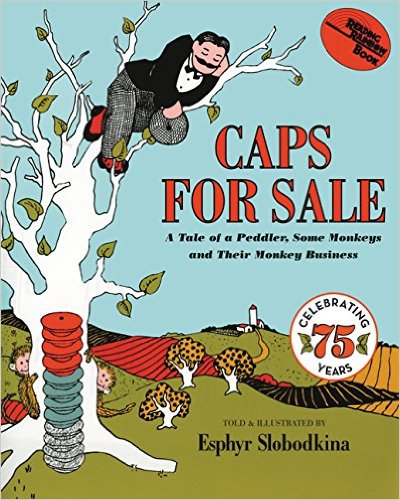 Caps for Sale: A Tale of a Peddler, Some Monkeys, and Their Monkey Business
Caps for Sale: A Tale of a Peddler, Some Monkeys, and Their Monkey Business
Written and Illustrated by Esphyr Slobodkina
This endearing book, with its captivating illustrations, made Gabriel laugh whenever the mischievous monkeys fiddled with the pile of caps on the peddler’s head. My son was still too young for me to tell him that both his Jewish great-grandfathers were street peddlers when they arrived in Cuba escaping pogroms in Russia and the army in Turkey. It brought tears to my eyes to imagine the hardship they suffered going from door to door in the sweltering heat trying to sell their wares and begin a new life on a tropical island. “Why are you crying, Mommy?” Gabriel would ask. I’d smile and say, “I’ll tell you when you grow up.”
(W. R. Scott, 1940).
Order a Copy Now: Indiebound | Amazon | Barnes and Noble
Ages 4-8 | Publisher: HarperCollins | 1987 (Reissue) | ISBN-13: 978-0064431439
 The Runaway Bunny
The Runaway Bunny
Written by Margaret Wise Brown
Illustrated by Clement Hurd
Some have said that The Runaway Bunny is a tender book, reassuring children that their mothers will never abandon them, while others find it creepy, the mother a little too omnipresent and stalking her child. I understand both perspectives, but I fall a little more on the positive side of the spectrum as the fear of abandonment was very strong in me as a child. After we left Cuba, my parents were overwhelmed with financial and other worries and I craved their attention. I had to fend for myself from a young age. Reading The Runaway Bunny to Gabriel, I came to feel more secure as a mother. With each reading, I made a vow to always be there for him. I also counted our blessings. Thankfully, we were living in a quiet place, from which I prayed we’d never have to uproot ourselves.
(HarperCollins, 1942).
Order a Copy Now: Indiebound | Amazon | Barnes and Noble
Ages 4-8 | Publisher: HarperCollins | 2017 (Revised) | ISBN-13: 978-0064430180
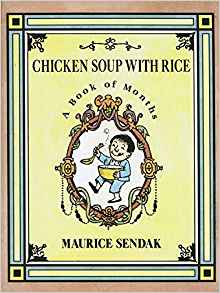 Chicken Soup with Rice: A Book of Months
Chicken Soup with Rice: A Book of Months
Written and Illustrated by Maurice Sendak
We read all of Maurice Sendak’s books for children, including, of course, the incomparable Where the Wild Things Are. But there was something especially wonderful about Chicken Soup with Rice. This was before The Chicken Soup for the Soul book series. It was comforting to read aloud the repetitive chant, “Happy once/happy twice/happy chicken soup/with rice.” Our little family of three had moved to Michigan, where I’d found a job as a professor, far from my mother in New York and my grandmother in Miami Beach. I really missed Mami’s and Baba’s chicken soup. My chicken soup didn’t come close to their healing brew. I was grateful to Sendak for helping me teach Gabriel to add rice to soup, which is so utterly delicious.
(HarperCollins, 1962)
Order a Copy Now: Indiebound | Amazon | Barnes and Noble
Ages 4-8 | Publisher: HarperCollins | 1991 (Reprint) | ISBN-13: 978-0064432535
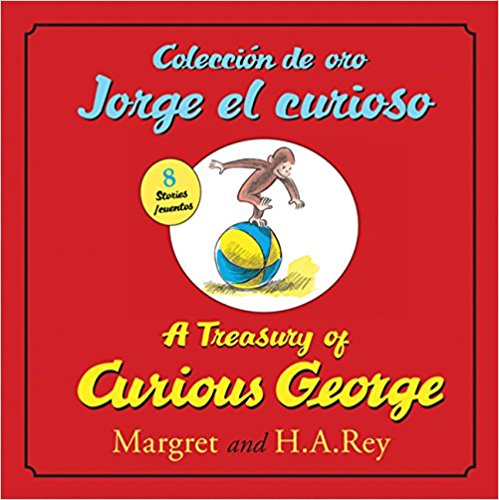 Jorge el Curioso
Jorge el Curioso
Written by Margret Rey and H. A. Rey
Illustrated by H. A. Rey
Latino literature for kids was just about to burst on the scene in the early 1990s when Gabriel was young enough to be read to. We missed the era, soon to come, of children’s books by Cuban-American writers Alma Flor Ada and Margarita Engle. The House on Mango Street by Sandra Cisneros, which appeared in 1984 with a Latino press, was not yet widely known; it would be a few years before it was heralded as a pioneering work of young people’s literature with a Latina as the main character. At the time, I was excited when I learned that Curious George had been translated into Spanish. I spoke Spanish to Gabriel almost exclusively, but wasn’t sure if he was learning it. As I read Jorge el Curioso to him, I realized he understood Spanish perfectly and that made me very happy. I noticed that the translator had chosen to translate “monkey” as “monito,” using the diminutive to show how cute Jorge was, rather than the more proper, but distancing, “mono.” We use diminutives constantly in Cuban Spanish, so I felt at home in the translation. I remember wishing I’d been able to read every book to Gabriel in bilingual editions. I think it is marvelous that we live in a time now of many more diverse books and many more translated books. Let’s please hold on to that and continue building bridges between all our languages and cultures.
(Houghton Mifflin, 1941, translated into Spanish, 1990).
Order a Copy Now: Indiebound | Amazon | Barnes and Noble
Ages 4-7 | Publisher: HMH Books for Young Readers | 2011 (Bilingual) | ISBN-13: 978-0547523101
###
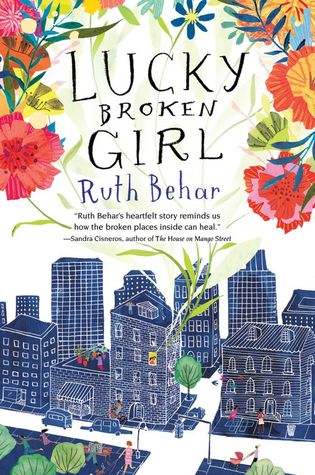 Lucky Broken Girl
Lucky Broken Girl
Written by Ruth Behar
Publisher’s Synopsis: In this unforgettable multicultural coming-of-age narrative—based on the author’s childhood in the 1960s—a young Cuban-Jewish immigrant girl is adjusting to her new life in New York City when her American dream is suddenly derailed. Ruthie’s plight will intrigue readers, and her powerful story of strength and resilience, full of color, light, and poignancy, will stay with them for a long time.
Ruthie Mizrahi and her family recently emigrated from Castro’s Cuba to New York City. Just when she’s finally beginning to gain confidence in her mastery of English—and enjoying her reign as her neighborhood’s hopscotch queen—a horrific car accident leaves her in a body cast and confined her to her bed for a long recovery. As Ruthie’s world shrinks because of her inability to move, her powers of observation and her heart grow larger and she comes to understand how fragile life is, how vulnerable we all are as human beings, and how friends, neighbors, and the power of the arts can sweeten even the worst of times.
Ages 10+ | Publisher: Nancy Paulsen Books | April 11, 2017 | ISBN-13: 978-0399546440
Available Here:
About the Author
Ruth Behar (www.ruthbehar.com) is an acclaimed author of adult fiction and nonfiction, and Lucky Broken Girl is her first book for young readers. She was born in Havana, Cuba, grew up in New York City, and has also lived and worked in Spain and Mexico. An anthropology professor at the University of Michigan, she is also co-editor of Women Writing Culture, editor of Bridges to Cuba/Puentes a Cuba, and co-editor of The Portable Island: Cubans at Home in the World. Her honors include a MacArthur “Genius” Award, a John Simon Guggenheim Fellowship, a Fulbright Senior Fellowship, and a Distinguished Alumna Award from Wesleyan University. Much in demand as a public speaker, Ruth’s speaking engagements have taken her to the United States, Canada, Argentina, Mexico, Cuba, Spain, Finland, Israel, Italy, Ireland, Poland, England, the Netherlands, Japan, and New Zealand. She lives in Ann Arbor, Michigan.
Ruth Behar, author of Lucky Broken Girl, selected these five family favorites. Discover more articles on The Children’s Book Review tagged with Family Favorites.

